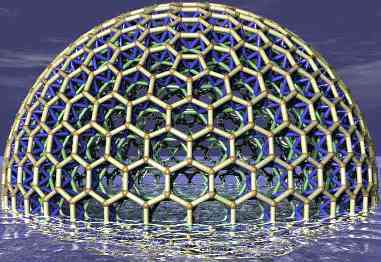
HexDome
Hexagonal Geodesic Domes - Woven Domes
Triaxial weaving


Triaxial weaving produces material which is structurally superior to most
sorts of rectangular weaving - and is very resistant to shearing forces.
For many years triaxial fabrics were the subject of a patent:
See [here] for details.
Woven Sphere

Here's a woven sphere I made.
It's based on a modelling a twisted icosahedron using triaxial weaving.
The sphere has 12 pentagons and 60 hexagons.
I made the sphere using wooden struts which I obtained by
disassembling a roller blind. Sets of two struts were
linked into rings using PVC tubing. The results were then
woven together.
Woven spheres have no hubs - and are cheap and easy to make.
The can be constructed from PVC, steel or wood.
Theory
Woven spheres are remarkably strong - and seem significantly
more resistant to "dimpling" than more conventional geodesic
structures.
Analysis suggests that the concave region of each strut is
under continuous pressure - while the convex regions are
under continuous tension. Such spheres thus share some of
their properties with tensegrity systems.
Triaxial baskets



Basket makers in South-East Asia use triaxial weaving techniques to make baskets.
Other woven spheres






References
Tim Tyler |
Contact |
http://hexdome.com/
|